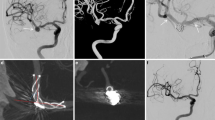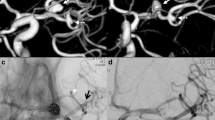Abstract
Introduction
The novel Low-profile Visualized Intraluminal Support (LVIS™, LVIS and LVIS Jr.) device was recently introduced for stent-supported coil embolization of intracranial aneurysms. Periprocedural and midterm follow-up results for its use in stent-supported coil embolization of unruptured aneurysms are presented herein.
Methods
In this prospective multicenter study, clinical and radiologic outcomes were analyzed for 55 patients with saccular aneurysms undergoing LVIS-assisted coil embolization between October 2012 and February 2013. Magnetic resonance angiography or digital subtraction angiography was performed to evaluate midterm follow-up results.
Results
The standard LVIS device, deployed in 27 patients, was more often used in internal carotid artery (ICA) aneurysms (n = 19), whereas the LVIS Jr. (a lower profile stent, n = 28) was generally reserved for anterior communicating artery (n = 14) and middle cerebral artery (n = 8) aneurysms. With LVIS-assisted coil embolization, successful occlusion was achieved in 45 aneurysms (81.8 %). Although no instances of navigation failure or stent malposition occurred, segmentally incomplete stent expansion was seen in five patients where the higher profile LVIS was applied to ICA including carotid siphon. Procedural morbidity was low (2/55, 3.6 %), limited to symptomatic thromboembolism. In the imaging of lesions (54/55, 98.2 %) at 6-month follow-up, only a single instances of major recanalization (1.9 %) occurred. Follow-up angiography of 30 aneurysms (54.5 %) demonstrated in-stent stenosis in 26 (86.7 %), with no instances of stent migration. Only one patient suffered late delayed infarction (modified Rankin Scale 1).
Conclusion
The LVIS device performed acceptably in stent-assisted coil embolization of non-ruptured aneurysms due to easy navigation and precise placement, although segmentally incomplete stent expansion and delayed in-stent stenosis were issues.






Similar content being viewed by others
References
Lee SJ, Cho YD, Kang HS et al (2013) Coil embolization using the self-expandable closed-cell stent for intracranial saccular aneurysm: a single-center experience of 289 consecutive aneurysms. Clin Radiol 68:256–263
Piotin M, Blanc R, Spelle L et al (2010) Stent-assistedcoiling of intracranial aneurysms: clinical and angiographic results in 216 consecutive aneurysms. Stroke 41:110–115
Gory B, Klisch J, Bonafé A et al (2013) Solitaire AB stent-assisted coiling of wide-necked intracranial aneurysms: short-term results from a prospective, consecutive, European multicentric study. Neuroradiology 55:1373–1378
Kulcsár Z, Göricke SL, Gizewski ER et al (2013) Neuroform stent-assisted treatment of intracranial aneurysms: long-term follow-up study of aneurysm recurrence and in-stent stenosis rates. Neuroradiology 55:459–465
Juszkat R, Nowak S, Smól S et al (2007) Leo stent for endovascular treatment of broad-necked and fusiform intracranial aneurysms. Interv Neuroradiol 13:255–269
Spiotta AM, Miranpuri A, Chaudry MI et al (2013) Combined balloon stent technique with the Scepter C balloon and low-profile visualized intraluminal stent for the treatment of intracranial aneurysms. J Neurointerv Surg 5(Suppl 3):iii79–iii82
Wanke I, Forsting M (2008) Stents for intracranial wide-necked aneurysms: more thanmechanical protection. Neuroradiology 50:991–998
Aenis M, Stancampiano AP, Wakhloo AK et al (1997) Modeling of flow in a straight stented and nonstented side wall aneurysm model. J Biomech Eng 119:206–212
Phatouros CC, Sasaki TY, Higashida RT et al (2000) Stent-supported coil embolization: the treatment of fusiform and wide-neck aneurysms and pseudoaneurysms. Neurosurgery 47:107–113
Roy D, Milot G, Raymond J (2001) Endovascular treatment of unruptured aneurysms. Stroke 32:1998–2004
Cho WS, Kang HS, Kim JE et al (2014) Angle change of the parent arteries after stent-assisted coil embolization of the wide-necked intracranial bifurcation aneurysms. Clin Radiol 69:e63–e70
Mocco J, Snyder KV, Albuquerque FC et al (2009) Treatment of intracranial aneurysms with the Enterprise stent: a multicenter registry. J Neurosurg 110:35–39
Kadkhodayan Y, Rhodes N, Blackburn S et al (2013) Comparison of Enterprise with Neuroform stent-assisted coiling of intracranial aneurysms. AJR Am J Roentgenol 200:872–878
Gentric JC, Biondi A, Piotin M et al (2013) Safety and efficacy of Neuroform for treatment of intracranial aneurysms: a prospective, consecutive, French multicentric study. AJNR Am J Neuroradiol 34:1203–1208
Krischek O, Miloslavski E, Fischer S et al (2011) A comparison of functional and physical properties of self-expanding intracranial stents [Neuroform3, Wingspan, Solitaire, Leo+, Enterprise]. Minim Invasive Neurosurg 54:21–28
Turner RD, Turk A, Chaudry I (2013) Low-profile visible intraluminal support device: immediate outcome of the first three US cases. J Neurointerv Surg 5:157–160
Valdivia y Alvarado M, Ebrahimi N, Benndorf G (2009) Study of conformability of the new leo plus stent to a curved vascular model using flat-panel detector computed tomography (DynaCT). Neurosurgery 64(3 Suppl):130–134
Gao B, Baharoglu MI, Cohen AD et al (2012) Stent-assisted coiling of intracranial bifurcation aneurysms leads to immediate and delayed intracranial vascular angle remodeling. AJNR Am J Neuroradiol 33:649–654
Gao B, Baharoglu MI, Cohen AD et al (2013) Y-Stent coiling of basilar bifurcation aneurysms induces a dynamic angular vascular remodeling with alteration of the apical wall shear stress pattern. Neurosurgery 72:617–629
Mocco J, Fargen KM, Albuquerque FC et al (2011) Delayed thrombosis or stenosis following Enterprise-assisted stent-coiling: is it safe?: midterm results of the Interstate Collaboration of Enterprise Stent Coiling. Neurosurgery 69:908–913
Fiorella D, Albuquerque FC, Woo H et al (2006) Neuroform in-stent stenosis: incidence, natural history, and treatment strategies. Neurosurgery 59:34–42
Kanaan H, Jankowitz B, Aleu A et al (2010) In-stent thrombosis and stenosis after neck-remodeling device-assisted coil embolization of intracranial aneurysms. Neurosurgery 67:1523–1532
Yoon KW, Kim YJ (2010) In-stent stenosis of stent assisted endovascular treatment on intracranial complex aneurysms. J Korean Neurosurg Soc 48:485–489
Chalouhi N, Drueding R, Starke RM et al (2013) In-stent stenosis after stent-assisted coiling: incidence, predictors and clinical outcomes of 435 cases. Neurosurgery 72:390–396
Köster R, Vieluf D, Kiehn M et al (2000) Nickel and molybdenum contact allergies in patients with coronary in-stent restenosis. Lancet 356:1895–1897
Saito T, Hokimoto S, Oshima S et al (2009) Metal allergic reaction in chronic refractory in-stent restenosis. Cardiovasc Revasc Med 10:17–22
Gao B, Safain MG, Malek AM (2014) Enterprise stenting for intracranial aneurysm treatment induces dynamic and reversible age-dependent stenosis in cerebral arteries. J Neurointerv Surg. doi:10.1136/neurintsurg-2013-011074
Acknowledgments
This study was supported by Microvention Inc. for clinical trials of LVIS devices.
Ethical standards and patient consent
We declare that all human and animal studies have been approved by the Institutional Review Board of Seoul National University Hospital and have therefore been performed in accordance with the ethical standards laid down in the 1964 Declaration of Helsinki and its later amendments. We declare that all patients gave informed consent prior to inclusion in this study.
Conflict of interest
We declare that we have no conflict of interest.
Author information
Authors and Affiliations
Corresponding author
Rights and permissions
About this article
Cite this article
Cho, Y.D., Sohn, CH., Kang, HS. et al. Coil embolization of intracranial saccular aneurysms using the Low-profile Visualized Intraluminal Support (LVIS™) device. Neuroradiology 56, 543–551 (2014). https://doi.org/10.1007/s00234-014-1363-x
Received:
Accepted:
Published:
Issue Date:
DOI: https://doi.org/10.1007/s00234-014-1363-x




